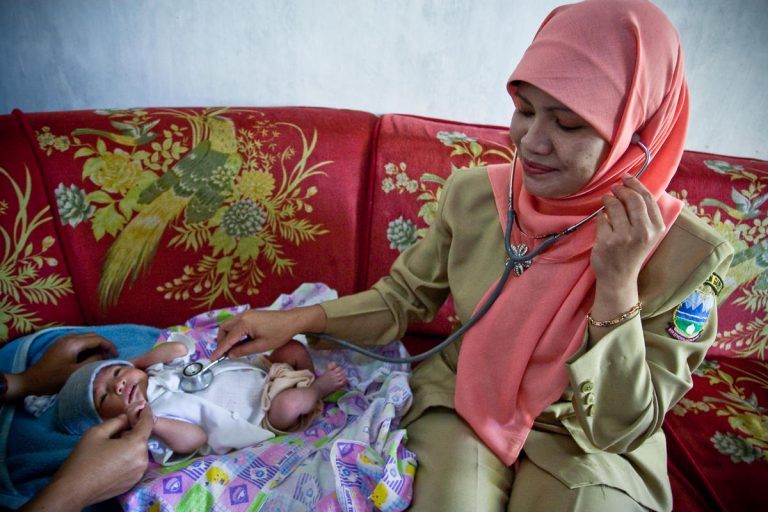“Every death counts. The death of a mother or a newborn is not just a tragedy for the family but also an indicator of an egregious failure of the health system, especially because many of these tragic deaths are preventable.” (Saifuddin Ahmed and Judith Fullerton in the editorial of “Expanding Maternal and Newborn Survival Opportunities in Indonesia” the supplement in IJGO 2019)
Indonesia’s maternal and newborn health indicators have lagged behind many of its Southeast Asian neighbors. Maternal mortality ratios remain high (126 per 100,000 live births in 2015), despite high coverage of antenatal care (95%), high skilled birth attendance (93%), and high postnatal care for mothers (80%), signifying gaps in the quality of care. Newborn mortality in 2017 was 12 deaths per 1,000 live births (access data sources here). Globally, it is widely acknowledged that improving the quality of healthcare, especially in the low- and middle-income countries will be essential for achieving the health-related targets of the Sustainable Development Goals (SDG).
Despite Indonesia having the largest economy in the region, there were several gaps within Indonesia’s maternal and neonatal service delivery system that needed to be addressed to accelerate mortality reductions. First, although facility-based deliveries were increasing, maternal and newborn deaths continued to be high in hospitals. Second, emergency referrals were ad hoc and not systematic. Third, inefficiencies within the health financing system made it difficult for vulnerable women and children to seek care contributing to delays in care seeking and referral. Fourth, there were great inequities in quality of services between geographic locations and socio-economic classes. Finally, there was a lack of transparency in the quality of care and accountability to civil society.
In 2011, USAID and the Indonesian Government launched the Expanding Maternal and Survival (EMAS) program, which was led by Jhpiego and partners, Save the Children, Research Triangle Institute (RTI), Lembaga Kesehatan Budi Kemuliaan (LKBK), and Muhammadiyah. EMAS was designed to (1) improve the quality of emergency obstetric and newborn care services in hospitals and puskesmas; (2) increase the efficiency and effectiveness of referral systems; and (3) increase accountability through local government and civic engagement. EMAS approaches were designed to help districts and facilities operationalize existing Government of Indonesia policies and programs with EMAS tools and approaches crafted to enable facilities to readily meet government standards for the provision of emergency maternal and newborn care within facilities and throughout the referral process—and to be funded using local budgets.
In February, a special supplement of the International Journal of Gynecology & Obstetrics was dedicated to ‘Expanding Maternal and Neonatal Survival Opportunities in Indonesia.’ The issue highlights the programmatic findings and lessons learned from the EMAS program. This journal issue contains papers that (i) illustrate the trends in case fatality rates and very early neonatal mortality rates at hospitals in selected districts in Indonesia; (ii) the effect of EMAS interventions on improved facility-based labor and childbirth care; and (iii) describe the effect of EMAS on improved effectiveness of the referral system to facilitate timely and effective management of complications. This issue comprises seven articles.
Some overarching lessons from EMAS include:
- Case Fatality Rate (CFR) from obstetric complications decreased significantly by 50% on average during the EMAS program period (5.4 to 2.6 deaths per 1000 cases).
- Very early neonatal mortality (deaths within 24 hours) decreased by 21% (4.8 to 3.3 deaths per 1000 live births) during the EMAS program period.
- Newborn resuscitation equipment readiness contributed to enhanced care for newborns. A comparison analysis between EMAS intervention hospitals and comparison hospitals found a composite newborn resuscitation score (Ambu bag and mask; suction equipment and a hard surface to perform resuscitation) of 98.9% versus 65.5%.
- Less than half of women admitted with postpartum hemorrhage or severe preeclampsia or eclampsia received consultation from an obstetrician/gynecologist and only 30% of them received the consultation in person.
- Results from a maternal death audit study of 11 hospitals showed that 90% of maternal deaths were preventable.
- Measurement is critical for improvement. Using data from both the health information monitoring system, the quasi-experimental study surveys, and a maternal death audit provided valuable information on the performance of the EMAS program as well as quality of care to understand why mothers and their babies were dying and how they can be prevented.
